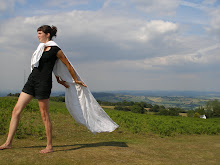Long silence... It had something to do with the fact that each post took me four days to write, but mostly it was the confusing position I found myself in. Do I want to be a baker? Yes. What sort of baker do I want to be? I don't know.
First, cue plans on bits of paper, flow charts, financial breakdowns (Zero £ divided by... = Zero £, it turns out, but 100% enthusiasm and bags of energy add up to something) and then descent, or is it ascent?, into soul-searching. I have returned to London to find what I'd always tried not to give in to: this city spins too fast for me. I have delighted in a few days spent at home (my parents' house, as opposed to that messy and significantly oven-less den in Squatney, London, that I pretend is home).
What to do? Buy lottery tickets? Sit and dream? Come on, Dilly, Act! In an effort to get back to my pre-pasta shape, I have been out in the garden, digging. Me and Ma Boase have planted wheat! Andy Forbes has given us 4 grams each of Hatif Inversable, Ile de Noe, Atle, April Bearded, Red Fife, Marsters A1 and Hickling de Mars, 10 grams of Old Welsh April Bearded (“because-” Andy says, “-it's going home”) and 100 grams of Paragon, the only Spring wheat recommended by the National Association of British and Irish Millers – i.e. fail-safe, hopefully. You can apply for your planting wheat here: http://www.brockwell-bake.org.uk We had to plant them on the 19th and 20th of March, according to the Biodynamic calendar of the man who'd supplied the grains to Andy. As I only arrived in the evening, this meant planting in the dark, which was funny but may be evident in the resulting growth patterns of the rows of wheat plants. That's assuming they'll grow at all. I decided that it was a good thing as, if I couldn't see the grains neither could our greedy local pigeon population. Next morning the dawn chorus is loud enough to wake me – the 'free food!' news is obviously out.
Why am I planting wheat? Not really for making bread commercially – there wouldn't be enough. It's more to see what wheat is like to grow and how different the varieties are from each other. I visited Andy last week in Brixton. He invites me in with a cheery “Come in, you can help me mill some wheat!” His Chinese millstones (bought from Ebay where they were being sold for turning into water-features) are incongruously placed in the window of his front room. Milling involves feeding grain slowly into the central hole in the top stone, turning the free-spinning handle to turn the top stone against the bottom one, and collecting the milled grain from the gutter around the base. I mill, he sieves, we have flour. It's amazing - a good mill opens up the grain's little bran jacket like, well, opening a jacket, and rubs the flour (the starchy endosperm) from it – depending on the grade of sieve and the number of times you put the wheat through the mill, you can make fine white flour and bran, or brown flour with the bran worked into it.
A few days later Andy comes to lunch. He brings a loaf of the most gorgeous bread, made from The flour. It is a sourdough, just flour, water, salt and his home-cultured leaven, but the flavour is complex and rich as if it contained caramel, olive oil, liquorice, cinnamon, all sorts of flavours that warm the heart. I am inspired.
Next thing to do is build the oven. I've dreamed about this for ages, but now I've just got to do it. I have re-found my book called The Bread Builders: Hearth Loaves and Masonry Ovens by Alan Scott and Daniel Wing. I've got another book called Build Your Own Earth Oven by Kiko Denzer and Hannah Field which gives instructions for a much more organic 'adobe' (mud and straw) type oven, as my friend Andy (see above) has built on his allotment.
Adobe is cheaper and I am tempted by the malleability/carve-able quality of mud (the book includes pictures of ovens in the shapes of squirrels, dragons, etc., my favourite being an eagle that looks like a big, fat robin – imagine having a eight-foot one of those on your garden!) However, there is the risk that adobe can drop grit into the bread, and also risks slumping if it gets wet. In rainy South Wales, a masonry oven might be safer.
So, lots of technical stuff about concrete to wade through (wading through the technical stuff, not the concrete). The trouble is ambition and maybe avarice – not for money, but for the type of beautiful ovens I saw on my travels – the one in Altamura that was big enough to live in, the one in France that looked like a snug cottage in the grounds of the Château de Machy, the oven in Pompeii that survived the devastating eruption of Vesuvius, and then for nearly two thousand years after... The Scott and Wing ovens do at least look like small churches, so maybe even trying to just do it straight from the instructions will result in something remarkable. I'll endeavour to keep you posted.

You're back posting! yippie :)
ReplyDeleteWoop woop!
ReplyDelete